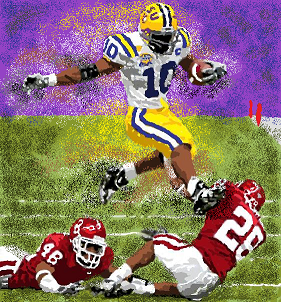1)
Southern Cal 12-1
2) Louisiana State 13-1
3) Oklahoma 12-2
4) Ohio State 11-2
5) Miami (FL) 11-2
6) Michigan 10-3
7) Georgia 11-3
8) Iowa 10-3
9) Washington State 10-3
10) Miami (OH) 13-1
11) Florida State 10-3
12)
Texas 10-3
13) Mississippi 10-3
14) Kansas State 11-4
15) Tennessee 10-3
16) Boise State 13-1
17) Maryland 10-3
18) Purdue 9-4
19) Nebraska 10-3
20) Minnesota 10-3
21) Utah 10-2
22) Clemson 9-4
23) Bowling Green 11-3
24) Florida 8-5
25) Texas Christian 11-2
This is the first AP poll I've fixed thus far with a problem at the top of the list. BCS champion Louisiana State played 5 AP top 25 teams and defeated four of them. The AP poll's #1 team, Southern Cal, played 2 AP top 25 teams and defeated them both, but took their loss to an unranked opponent.
How many national champions have played as few as 2 rated opponents? Southern Cal 2003 is the last one to do so. Since that time, every national champion has defeated at least four rated opponents. Kind of like LSU in 2003. The last national champion to defeat fewer than four was Michigan 1997, but that year was similar to 2003, as the national co-champion and AP #2 team, Nebraska, did defeat four rated opponents.
To find a national champion that played a weaker schedule than USC 2003, we have to go all the way back to 1984, when Brigham Young played no rated teams and became the worst "national champion" of all time. In fact, I do not personally recognize BYU '84 as a national champion at all.
I do, however, recognize Southern Cal as a national co-champion of 2003. The question is, can they logically, validly be ranked #1? LSU obviously played a tougher schedule. And they won their games by a slightly higher average margin of victory (22.9 to 22.7). Case Closed? Almost, but not quite...

13-1 LSU ran over Oklahoma 21-14 for the 2003 BCS national championship. But Southern Cal held them off for the AP poll's top spot, winning the Rose Bowl 28-14 over 10-3 Michigan.
